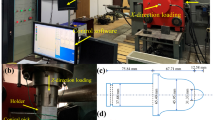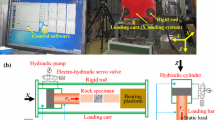Abstract
This article establishes a new model for estimating the peak indentation force of the edge chipping of rocks when using a conical or a pyramidal point-attack pick. The investigation points out that the existing formulation in the literature is based on an inappropriate stress assumption and equilibrium, and hence leads to incorrect cutting force estimations. The new model developed in this study is based on an analysis of the penetration force and energy dissipation using fracture mechanics, similarity of chip geometry, and edge chipping tests on four different rock materials. It is found that the peak indentation force and the depth of cut follow a power law, that the new model can reasonably estimate the experimental measurements, and that it provides useful information for the shape optimization of point-attack picks in mechanical excavation.










Similar content being viewed by others
References
Almond E, McCormick N (1986) Constant-geometry edge-flaking of brittle materials. Nature 321(6065):53–55
Balci C, Bilgin N (2007) Correlative study of linear small and full-scale rock cutting tests to select mechanized excavation machines. Int J Rock Mech Min Sci 44(3):468–476
Bilgin N, Yazici S, Eskikaya S (1996) A model to predict the performance of roadheaders and impact hammers in tunnel drivages. In: International Eurock 96 Symposium, Torino, 2–5 Sep
Bilgin N, Demircin MA, Copur H, Balci C, Tuncdemir H, Akcin N (2006) Dominant rock properties affecting the performance of conical picks and the comparison of some experimental and theoretical results. Int J Rock Mech Min Sci 43(1):139–156
Chai H, Lawn B (2007) A universal relation for edge chipping from sharp contacts in brittle materials: a simple means of toughness evaluation. Acta Mater 55(7):2555–2561
Cheatham J Jr (1958) An analytical study of rock penetration by a single bit tooth. In: Eighth annual drilling and blasting symposium, University of Minnesota, pp 2–4
Copur H, Bilgin N, Tuncdemir H, Balci C (2003) A set of indices based on indentation tests for assessment of rock cutting performance and rock properties. J S Afr Inst Min Metall 103(9):589–599
Dollinger GL, Handewith HJ, Breeds CD (1998) Use of the indentation tests for estimating TBM performance. In: lo KY (ed) Canadian tunneling, the annual publication of the tunneling association of canada, pp 27–33
Evans I (1984) A theory of the cutting force for point-attack picks. Geotech Geol Eng 2(1):63–71
Fowell R, Ochei N (1984) A comparison of dust make and energy requirements for rock cutting tools. Geotech Geol Eng 2(1):73–83
Gogotsi G, Mudrik S, Galenko V (2007) Evaluation of fracture resistance of ceramics: edge fracture tests. Ceram Int 33(3):315–320
Goktan R (1995) Prediction of drag bit cutting force in hard rocks. In: Ozdemir LHK (ed) Proceedings of the 3rd international symposium on mine mechanization and automation, Golden, Colorado, pp 10–31
Goktan R (1997) A suggested improvement on Evans’ cutting theory for conical bits. In: Gurgenci HHM (ed) Proceedings of the fourth international symposium on mine mechanization and automation, Brisbane, Queensland, pp 57–61
Goktan RM, Gunes N (2005) A semi-empirical approach to cutting force prediction for point-attack picks. J S Afr Inst Min Metall 105:257–263
Guo H, Aziz NI, Schmidt LC (1992) Rock cutting study using linear elastic fracture mechanics. Eng Fract Mech 41(5):771–778
Hood M, Alehossein H (2000) A development in rock cutting technology. Int J Rock Mech Min Sci 37(1–2):297–305
Huang H, Damjanac B, Detournay E (1998) Normal wedge indentation in rocks with lateral confinement. Rock Mech Rock Eng 31(2):81–94
Hurt K, Evans I (1981) Point attack tools: an evaluation of function and use for rock cutting. Min Eng 140:673–675
Hurt KG, McAndrew KM (1985) Cutting efficiency and life of rock-cutting picks. Min Sci Technol 2:139–151
Inyang HI (2002) Developments in drag bit cutting of rocks for energy infrastructure. Int J Surf Min Reclam Environ 16(4):248–260
Johnson KL (1987) Contact mechanics. Cambridge University Press, Cambridge
Khair AW (1996) The effects of bit geometry on rock cutting efficiency. Appl Occup Environ Hyg 11(7):695–700
Lawn B (1993) Fracture of brittle solids. Cambridge University Press, Cambridge
McCormick N (1992) Edge flaking as a measure of material performance. Met Mater 8(3):154–156
Mishnaevsky L (1995) Physical mechanisms of hard rock fragmentation under mechanical loading: a review. Int J Rock Mech Min Sci 32(8):763–766
Mishnaevsky Jr L (1998) Rock fragmentation and optimization of drilling tools. In: Aliabadi MH (ed) Fracture of rock, Computational Mechanics Publications, pp 167–203
Pang SS, Goldsmith W, Hood M (1989) A force-indentation model for brittle rocks. Rock Mech Rock Eng 22(2):127–148
Paul B, Sikarskie D (1965) A preliminary theory of static penetration by a rigid wedge into a brittle material. Trans Am Inst Min Metall Petrol Eng 232:372–383
Quinn J, Su L, Flanders L, Lloyd I (2000) Edge toughness and material properties related to the machining of dental ceramics. Mach Sci Technol 4(2):291–304
Ranman KE (1985) A model describing rock cutting with conical picks. Rock Mech Rock Eng 18(2):131–140
Roxborough FF, Liu ZC (1995) Theoretical considerations on pick shape in rock and coal cutting. In: TS G (ed) Proceedings of the sixth underground operator’s conference, Kalgoorlie, pp 189–193
Yilmaz NG, Yurdakul M, Goktan RM (2007) Prediction of radial bit cutting force in high-strength rocks using multiple linear regression analysis. Int J Rock Mech Min Sci 44(6):962–970
Zhang LC, Alexander AJ (2007) Cutting pick 2007903627
Zhang LC, Alexander AJ (2008) Cutting tip and tool PCT/AU2008/000969
Acknowledgments
The authors appreciate the financial support from the Australian Research Council and BRADKEN®.
Author information
Authors and Affiliations
Corresponding author
Additional information
R. H. Bao—On leave from Department of Mechanics, Zhejiang University, Hangzhou 310027, China.
Rights and permissions
About this article
Cite this article
Bao, R.H., Zhang, L.C., Yao, Q.Y. et al. Estimating the Peak Indentation Force of the Edge Chipping of Rocks Using Single Point-Attack Pick. Rock Mech Rock Eng 44, 339–347 (2011). https://doi.org/10.1007/s00603-010-0133-2
Received:
Accepted:
Published:
Issue Date:
DOI: https://doi.org/10.1007/s00603-010-0133-2




